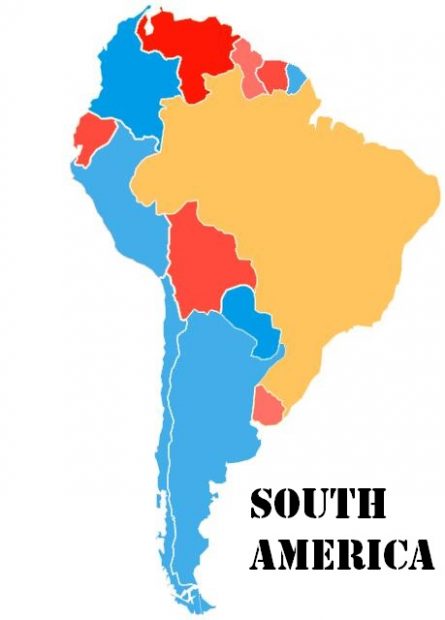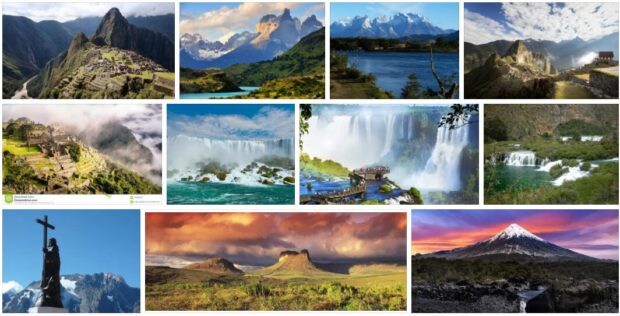Pre-Columbian history
America was probably originally a “deserted” continent. The first immigration (hunter-gatherer) from Asian Siberia via the then still mainland or icy Bering Strait was around 15,000 BC. (maybe earlier) detectable; the Inca Empire in Peru since 1200, peak in the 15th century AD.
Columbus and post-Columbian history
After the old West-East trade routes from Europe to India were blocked by the Turks, search for new sea routes to the riches of East Asia, especially through Portugal and Spain; the knowledge of the spherical shape of the earth led to attempts to reach India on the west route across the Atlantic. Discoveries in 1498: the north coast of South America; Discovery of Colombia (1499) and the La Plata countries (1518); Dias de Solis explored the east coast of South America in 1515/16; Crucial progress: Magellan was the first to sail around South America in 1519/20 (road named after him) and crossed the Pacific Ocean.
The discoveries were followed by conquests, the time of the conquistadors: the Welsers opened Venezuela, which Emperor Charles V mortgaged in 1527. Pizarro conquered the Inca Empire (Peru) from 1531 to 1536, Almagro, its rival, Chile, Paraguay and Bolivia (1535 to 1537). At the same time as the Spanish colonial empire, a Portuguese colonial estate developed. The demarcation line by Pope Alexander VI formed the basis for the demarcation of the two rival colonial powers. determined at the request of the Spanish King Ferdinand in 1493 and confirmed by the Spanish-Portuguese Treaty of Tordesillas in 1494 (21st degree as a border line, which was incorrectly defined, however, so that Brazil became Portuguese, Argentina, Mexico, etc.). The first to enter Brazil by Cabral has been colonized by the Portuguese since 1530;
In the first half of the 19th century, Spanish and Portuguese South America became independent: the emergence of the independent states of Latin America. The European colonial policy on the American continent was thus ended to a small extent.
During World War II, almost all Latin American countries went to war alongside the United States. In 1948, the Organization of American States (or OAS abbreviated on Abbreviationfinder) was established in Bogotá under the leadership of the United States.
| Countries | Proportion of women working (percent) | Proportion of men working (percent) |
| Argentina | 49.0 (2018) | 72.8 (2018) |
| Bolivia | 56.6 (2018) | 79.3 (2018) |
| Brazil | 54.0 (2018) | 74.4 (2018) |
| Chile | 51.0 (2018) | 74.2 (2018) |
| Colombia | 58.6 (2018) | 82.0 (2018) |
| Ecuador | 56.6 (2018) | 81.8 (2018) |
| Guyana | 41.2 (2018) | 73.6 (2018) |
| Paraguay | 56.9 (2018) | 84.1 (2018) |
| Peru | 69.9 (2018) | 84.7 (2018) |
| Suriname | 39.2 (2018) | 64.2 (2018) |
| Uruguay | 55.8 (2018) | 73.8 (2018) |
| Venezuela | 47.7 (2018) | 77.1 (2018) |
Central America (history)
According to Countryaah, there are 7 countries in the Central America as of 2021.
Pre-Columbian history
America was probably originally a “deserted” continent. The first immigration (hunter-gatherer) from Asian Siberia via the then still mainland or icy Bering Strait was around 15,000 BC. (maybe earlier) detectable; gradual transition to sedentary way of life (stone age talc cultures, beginnings of ceramics), settlement of the entire double continent to southern Patagonia. Hunters, collectors and planters developed advanced cultures, particularly in Central America and the highlands of Peru. Start of agriculture, later mainly corn crops. Cultural centers were the Mayan states in Guatemala, San Salvador and on the Yucatán peninsula. The Inca Empire in Peru since 1200, peak in the 15th century AD.
Columbus and post-Columbian history
After the old West-East trade routes from Europe to India were blocked by the Turks, search for new sea routes to the riches of East Asia, especially through Portugal and Spain; the knowledge of the spherical shape of the earth led to attempts to reach India on the west route across the Atlantic.
In 1492 Christopher Columbus landed on the Bahamian island of Guahaini, which was mistakenly regarded as the western extension of India (hence the name West Indies). The West Indies quickly came into the possession of the various colonial powers (Spain, England, Portugal, France, Holland), the Central American mainland under Spanish rule.
The mainland became independent of Spain as the “United States of Central America” in 1823, but fell apart in 1839 after violent internal turmoil. Most of the West Indies did not become independent until the second half of the 20th century.
During World War II, almost all Latin American countries went to war alongside the United States. In 1948, the Organization of American States (OAS) was established in Bogotá under the leadership of the United States.

